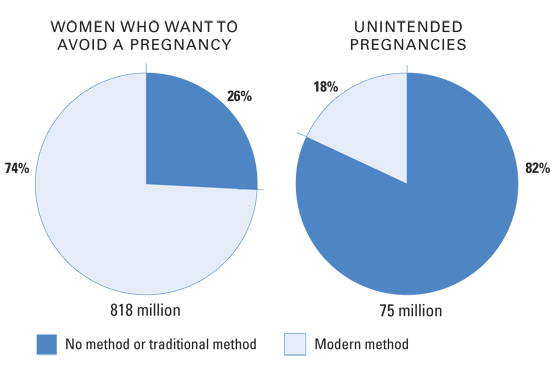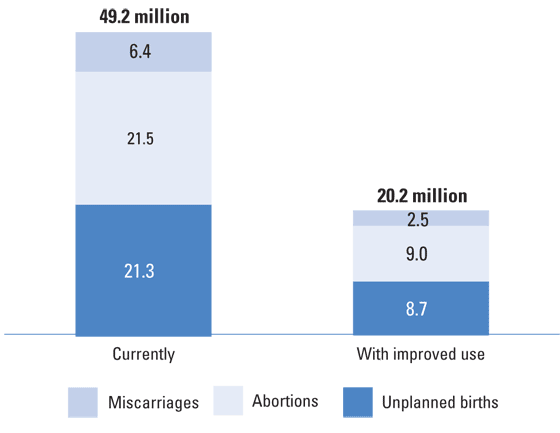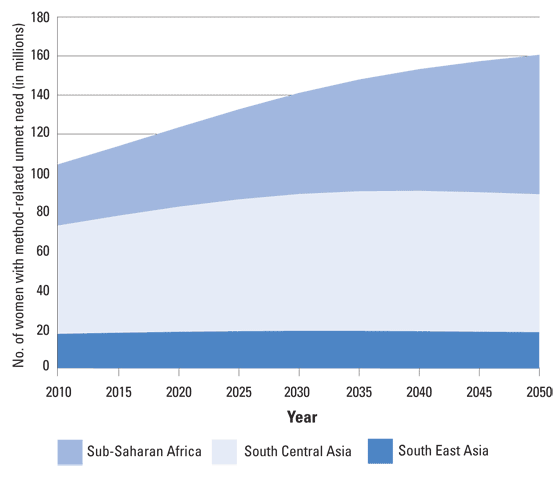The World at Seven Billion: A Global Milestone That Reflects the Needs of Seven Billion Individuals
Reaching seven billion people on planet Earth has prompted renewed debates about the balance between population size and consumption of natural resources, about age structure and political stability, and about the consequences of rapid population growth rates for poor countries' ability to develop economically. To a large extent, however, these macro-level dilemmas reflect a micro-level problem about which there is a universal consensus and where the solution is relatively straightforward.

Cross-posted with permission from the Guttmacher Institute.
This fall, world population will reach 7 billion people at a time of accelerated environmental disruption. This article is part of a series commissioned by Rewire to examine the causes and consequences of population and environmental change from various perspectives and the policies and actions needed to both avoid and mitigate the inevitable impacts of these changes.
All of the articles in this series can be found here.
According to the United Nations, the world’s population will reach seven billion later this year and, if current trends continue, will rise to more than nine billion by the middle of this century.1 This new population milestone—and the projection—prompt renewed debates about the balance between population size and consumption of natural resources, about age structure and political stability, and about the consequences of rapid population growth rates for poor countries’ ability to develop economically.
These relationships and others pertaining to population size and the rate of population growth are complex and their implications often controversial. To a large extent, however, these macro-level dilemmas reflect a micro-level problem about which there is a universal consensus and where the solution is relatively straightforward. Millions of women and couples, especially in the developing world, are still unable to control for themselves the timing, spacing and total number of their children. Recognition of this fact provides a road map for moving forward that can address the needs of the people and the planet at the same time.
That path forward must include a central focus on increasing access and eliminating barriers to voluntary contraceptive services. Responding directly to individual people’s needs and desires to determine for themselves whether and when to have a child will contribute significantly toward their ability to lead healthier, more productive lives. In turn, these benefits for individuals and families accrue to their communities and to society at large. Ultimately, the impact would be felt at the global level. Meeting the stated desires of all women around the world to space or limit births would result in the world’s population peaking within the next few decades—and then actually starting to decline.
Unmet Need: Origins, Levels and Consequences
Women and men worldwide are marrying later and wanting smaller families than their parents and grandparents did.2 Declines in fertility rates have followed: As of the early 2000s, the average number of children per woman in the developing world is three, compared with six in the 1960s.3 These demographic trends have accompanied increases in education and economic development. Wide variations continue to exist within and across regions, but in most places in the developing world, the desire for smaller families still outpaces the availability and use of modern contraception, which leads to unwanted births as well as high rates of abortion—usually illegal, clandestine and therefore unsafe.
At any given time, about 818 million women in developing countries—more than half of all those within the reproductive ages of 15 to 49—want to avoid becoming pregnant for at least two years.2 Owing in large part to the existence of family planning programs, more than 600 million are using modern contraceptives; however, 215 million are not. (Although some of these women use traditional methods, such as withdrawal or periodic abstinence, their pregnancy rate is so high that they are considered to be in need of modern methods as much as women who do not use birth control at all.) These 215 million women with an unmet need for contraception (i.e., those who are sexually active and want to stop or postpone childbearing, but are not using a modern contraceptive) account for more than 80% of all unintended pregnancies in the developing world each year (see chart).2
| MODERN METHODS MATTER |
|---|
| Most women who want to avoid pregnancy use a modern method of birth control; however, the relatively small group who do not account for more than eight in 10 of the 75 million unintended pregnancies worldwide each year. |
 |
| Source: Reference 2. |
Just over half of all women of reproductive age in the developing world live in three regions: Sub-Saharan Africa, South Central Asia and Southeast Asia.4 However, about seven in 10 of the 215 million women with an unmet need for modern contraception live in these areas. Not surprisingly, therefore, a disproportionate share (66%) of all unintended pregnancies in the developing world occurs to women living in these regions; virtually all (93%) maternal deaths take place here. Accordingly, the Guttmacher Institute studied these three regions more closely to gain a better understanding of the extent and reasons why so many women wishing to postpone or stop childbearing are not using modern methods of contraception.
Reasons and Remedies
In Contraceptive Technologies: Responding to Women’s Needs, Guttmacher researchers analyzed data from nationally representative Demographic and Health Surveys (DHS), surveys from the U.S. Centers for Disease Control and Prevention, and other independent surveys.4 The report details the levels of unmet need in Sub-Saharan Africa, South Central Asia and Southeast Asia, and provides an overview of the reasons women living in these areas who are at risk of unintended pregnancy are not using a modern method. The authors conclude that women’s reasons for nonuse often are multiple and interrelated, and they identify several steps for overcoming the existing barriers—the most important being the availability of new and better contraceptive technology.
According to the report, the characteristics of women with an unmet need for contraception vary according to their childbearing intentions (whether they want to delay having their first child, space subsequent births or have no more children at all), marital status, age, income and whether they live in urban or rural areas. In the three focus regions, the “typical” woman with unmet need for modern contraception is 25 or older, is married, has one or more children and lives in a rural area; about four in 10 are poor. If the woman lives in Sub-Saharan Africa, she likely wants more children after a delay of two or more years; however, if she lives in South Central or Southeast Asia, she probably has already had all the children she wants.
The reasons that so many women who want to avoid becoming pregnant are not using modern contraceptives also vary widely. Yet, notably, seven in 10 of these women express concerns related in some way to the methods themselves. This includes women concerned about the health risks or side effects of contraceptives, both real and perceived. It also includes those who mistakenly believe that they are at low risk of pregnancy, namely those who have sex infrequently, are postpartum or are breastfeeding; all of these women would benefit from better information about pregnancy risk and better counseling about methods compatible with their circumstances. And it includes women whose partners oppose contraception, for whom efforts to gain partner support are important but for whom the availability of methods that could be used without their partners’ knowledge also would be beneficial. The report’s authors conclude, therefore, that much greater investment in overcoming these method-related barriers is essential to making any real headway in reducing the unmet need.
Many of the remaining reasons women in these regions give for not using contraception could be remedied in the short term by improving access to the contraceptive methods that already exist. Those who indicate that they do not know where to go for services, that services are too far away or that their method of choice is too costly could benefit immediately. Women who are unaware of modern methods at all, as well as a small number who do not believe they could become pregnant, could benefit too.
Nevertheless, the most headway in reducing unintended pregnancy could be made by addressing the reasons for nonuse related to the problems women have with their current method choices, by better matching them with highly effective methods appropriate to their life circumstances—either methods available today or new, more advanced ones. If this could be accomplished, unintended pregnancy in the three developing regions could fall by as much as 59% (see chart).4 Unintended births and abortions could decline by a similar amount, and 70,000 maternal deaths could be averted.
| IF NEED WERE MET |
|---|
| Addressing women’s concerns about modern contraceptive methods and finding new methods they can use consistently and correctly could reduce unintended pregnancies in Sub-Saharan Africa, South Central Asia and Southeast Asia by nearly 60%. |
 |
| Note: Estimates for the “improved use” scenario assume that 71% of women with unmet need for modern methods (i.e., the proportion of women with unmet need who report method-related reasons for nonuse) adopt a new method with a use-effectiveness rate equal to that of the IUD. Source: Reference 4. |
“We can make headway immediately toward satisfying unmet need,” the authors state, “by ensuring that women who currently have unmet need for modern contraception receive accurate information about their risk of unintended pregnancy, have access to quality services that offer a range of methods, and receive counseling and care that helps them initiate and sustain method use.”4 However, given that the majority of women at risk of unintended pregnancy who are not using modern contraceptives—as well as a substantial proportion of those who discontinue use—have concerns or problems related to currently available methods, current methods need to be adapted to make them easier to use, and investment in the discovery and development of new and better methods is essential. Ultimately, the authors note, the goal is to increase the availability of methods “that do not cause systemic side effects, can be used on demand, and do not require partner participation or knowledge.”
People and the Planet
Evidence and experience make clear that most women in the developing and developed worlds alike want to have children. But they also want to control when they have them and how many they have. The ability and access to services necessary to act on this basic desire have increased dramatically over the last few decades. Still, for many women and couples, a multitude of barriers conspire to block or impede use of modern contraceptives. The consequences of inaction, meanwhile, continue to take a heavy toll on the health and lives of women and newborns. Moreover, if the current concerns of the women in Sub-Saharan Africa, South Central Asian and Southeast Asia are not addressed, the sheer numbers of women with an unmet need in these areas will continue to rise due to population growth alone (see chart, page 5).4
| RISING TIDE |
|---|
| Without changes in desired family size and contraceptive use, the number of women with an unmet need for more effective and acceptable modern methods in three developing world regions will rise to 161 million by 2050, with the sharpest increase occurring in Sub-Saharan Africa. |
 |
| Source: Reference 4. |
Increased political and financial commitment at the global level to achieving universal access to reproductive health is necessary if there is to be progress, for women and for the planet. The fact that the United Nations’ Millennium Development Goal aimed at improving maternal health, MDG 5, specifically calls for universal access to reproductive health care by 2015 is an important marker. It reflects the global consensus that this is a priority especially for poor countries. Even during this worldwide recession, it is noteworthy that donors, including the United States, and host-country governments are committing substantial resources to the global effort, though not enough to keep up with the need and demand for services. Fulfilling the unmet need for modern contraception, including the necessary information and counseling services, would contribute significantly toward meeting MDG 5. Indeed, it would aid progress toward all of the MDGs, which together represent a global antipoverty action plan.2 And in the process of meeting the unmet need, the effect on world population growth would be major.
In 2010, the Futures Group analyzed the demographic impact of meeting the unmet need for contraceptive services in 99 developing countries (excluding China) and the United States, whose combined population in 2005 was 4.3 billion.5 According to the model, if unmet need were fully met, the average fertility rate would drop to just below the replacement level by 2050. The Worldwatch Institute’s Robert Engelman considers the implications potentially “momentous.”6 Fully meeting the existing unmet need, says Engelman, could end world population growth. This does not even take into account the possible added fertility declines that could result among women who currently still desire large families, but who could change their minds because of the effects of increased girls’ education levels, enhanced women’s empowerment, improved maternal and newborn health and survival rates, and overall economic development.
Engleman maintains that “there is nothing fated about a world of 9 billion people—in 2050, or ever.” It is eminently possible, he asserts, to make policy choices that would lead to a world population size that is more environmentally and socially sustainable, and does not in any way involve “control” or coercion, let alone forcing individuals to forswear the benefits of economic advancement. These choices, he notes, “are rooted in human development and human rights, specifically the right of all, and most directly of women, to decide for themselves when it is the right time to bring a new child into the world.”
REFERENCES
1. United Nations, World population to reach 10 billion by 2100 if fertility in all countries converges to replacement level, May 3, 2011, <http://esa.un.org/unpd/wpp/other-information/Press_Release_ WPP2010.pdf>, accessed Aug. 10, 2011.
2. Singh S et al., Adding It Up: The Costs and Benefits of Investing in Family Planning and Maternal and Newborn Health, New York: Guttmacher Institute and United Nations Population Fund, 2009, <http://www.guttmacher.org/pubs/AddingItUp2009.pdf>, accessed Aug. 10, 2011.
3. Bruce J and Bongaarts J, The new population challenge, in: Mazur L, ed., A Pivotal Moment: Population, Justice, and the Environmental Challenge, Washington, DC: Island Press, 2009, <http://www.popcouncil.org/pdfs/2009PGY_NewPopChallenge.pdf>, accessed Aug. 10, 2011.
4. Darroch JE, Sedgh G and Ball H, Contraceptive Technologies: Responding to Women’s Needs, New York: Guttmacher Institute, 2011, <http://www.guttmacher.org/pubs/Contraceptive-Technologies.pdf>, accessed Aug. 10, 2011.
5. Futures Group, World Population Prospects and Unmet Need for Family Planning, 2010, <http://www.futuresgroup.com/wp-content/uploads/2010/04/Research-Brief_World-Population-Prospects-and-Unmet-Need-for-Family-Planning-10.07.10.pdf>, accessed Aug. 10, 2011.
6. Engelman R, An end to population growth: why family planning is key to a sustainable future, Solutions, 2011, Vol. 2, No. 3, <http:// www.thesolutionsjournal.com/node/919>, accessed Aug. 10, 2011.
